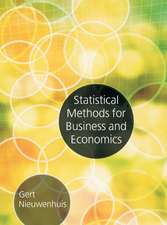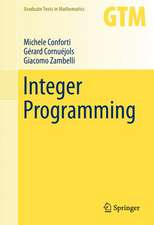Optimal Firm Behaviour in the Context of Technological Progress and a Business Cycle: Lecture Notes in Economics and Mathematical Systems, cartea 352
Autor Onno van Hiltenen Limba Engleză Paperback – 12 feb 1991
Din seria Lecture Notes in Economics and Mathematical Systems
-
 Preț: 360.02 lei
Preț: 360.02 lei -
 Preț: 383.93 lei
Preț: 383.93 lei -
 Preț: 384.09 lei
Preț: 384.09 lei -
 Preț: 380.07 lei
Preț: 380.07 lei -
 Preț: 446.26 lei
Preț: 446.26 lei -
 Preț: 497.37 lei
Preț: 497.37 lei -
 Preț: 380.84 lei
Preț: 380.84 lei -
 Preț: 384.86 lei
Preț: 384.86 lei -
 Preț: 378.34 lei
Preț: 378.34 lei -
 Preț: 399.67 lei
Preț: 399.67 lei - 20%
 Preț: 360.93 lei
Preț: 360.93 lei - 15%
 Preț: 643.16 lei
Preț: 643.16 lei -
 Preț: 379.09 lei
Preț: 379.09 lei -
 Preț: 404.74 lei
Preț: 404.74 lei -
 Preț: 385.62 lei
Preț: 385.62 lei - 15%
 Preț: 644.49 lei
Preț: 644.49 lei -
 Preț: 379.09 lei
Preț: 379.09 lei -
 Preț: 345.50 lei
Preț: 345.50 lei -
 Preț: 425.80 lei
Preț: 425.80 lei -
 Preț: 378.34 lei
Preț: 378.34 lei - 18%
 Preț: 775.65 lei
Preț: 775.65 lei -
 Preț: 392.60 lei
Preț: 392.60 lei -
 Preț: 401.61 lei
Preț: 401.61 lei - 15%
 Preț: 646.43 lei
Preț: 646.43 lei -
 Preț: 382.18 lei
Preț: 382.18 lei -
 Preț: 378.34 lei
Preț: 378.34 lei - 15%
 Preț: 637.59 lei
Preț: 637.59 lei - 15%
 Preț: 647.27 lei
Preț: 647.27 lei -
 Preț: 377.73 lei
Preț: 377.73 lei -
 Preț: 447.84 lei
Preț: 447.84 lei - 15%
 Preț: 644.49 lei
Preț: 644.49 lei -
 Preț: 386.00 lei
Preț: 386.00 lei - 15%
 Preț: 654.43 lei
Preț: 654.43 lei -
 Preț: 415.02 lei
Preț: 415.02 lei -
 Preț: 411.54 lei
Preț: 411.54 lei -
 Preț: 398.92 lei
Preț: 398.92 lei -
 Preț: 398.92 lei
Preț: 398.92 lei -
 Preț: 392.75 lei
Preț: 392.75 lei - 15%
 Preț: 635.47 lei
Preț: 635.47 lei - 20%
 Preț: 653.56 lei
Preț: 653.56 lei -
 Preț: 379.86 lei
Preț: 379.86 lei -
 Preț: 495.46 lei
Preț: 495.46 lei -
 Preț: 447.99 lei
Preț: 447.99 lei -
 Preț: 378.71 lei
Preț: 378.71 lei - 15%
 Preț: 637.13 lei
Preț: 637.13 lei -
 Preț: 385.84 lei
Preț: 385.84 lei -
 Preț: 378.54 lei
Preț: 378.54 lei - 15%
 Preț: 666.55 lei
Preț: 666.55 lei -
 Preț: 380.07 lei
Preț: 380.07 lei
Preț: 387.38 lei
Nou
Puncte Express: 581
Preț estimativ în valută:
74.14€ • 76.59$ • 61.70£
74.14€ • 76.59$ • 61.70£
Carte tipărită la comandă
Livrare economică 26 martie-09 aprilie
Preluare comenzi: 021 569.72.76
Specificații
ISBN-13: 9783540535638
ISBN-10: 3540535632
Pagini: 248
Ilustrații: XII, 233 p.
Dimensiuni: 170 x 242 x 13 mm
Greutate: 0.4 kg
Ediția:1991
Editura: Springer Berlin, Heidelberg
Colecția Springer
Seria Lecture Notes in Economics and Mathematical Systems
Locul publicării:Berlin, Heidelberg, Germany
ISBN-10: 3540535632
Pagini: 248
Ilustrații: XII, 233 p.
Dimensiuni: 170 x 242 x 13 mm
Greutate: 0.4 kg
Ediția:1991
Editura: Springer Berlin, Heidelberg
Colecția Springer
Seria Lecture Notes in Economics and Mathematical Systems
Locul publicării:Berlin, Heidelberg, Germany
Public țintă
ResearchCuprins
One Introduction.- Two A Selective Literature Survey.- Three On Dynamic Optimisation Models of the Firm as a Branch of ‘Pure Theory’ and on the Use of Mathematics.- Four The Basic Model.- Five A Model with a Business Cycle.- Six Shadow Prices in a Model with Pure State Constraints.- Seven Technological Progress in Vintage Models of the Firm: Scrapping Condition and Steady State.- Eight Optimal Policies in Models with Technological Progress, with and without a Business Cycle.- Nine Summary and Conclusions.- Appendix One Optimality Conditions for the Basic Model of Chapter 4.- A1.1 Necessary and sufficient conditions.- A1.2 The coupling procedure.- A1.2.1 The paths.- A1.2.2 Derivation of the final paths.- A1.2.3 The coupling procedure.- Appendix Two The Mathematical Details of Chapter 5.- A2.1 General remarks.- A2.2 The details of section 5.3.3.- A2.3 The details of section 5.3.4.- A2.4 The details of section 5.3.5.- A2.5 Uniqueness of the solution.- A2.6 Numerical illustrations.- A2.7 The details of section 5.4.- Appendix Three On the Shadow Price Interpretation of the Multipliers of Pure State Constraints in Optimal Control Problems.- A3.1 Introduction.- A3.2 The class of models to be considered.- A3.3 An outline of the proof.- A3.4 A general sensitivity result.- A3.6 The Kuhn-Tucker conditions and Theorem 1 for problem II.- Appendix Four Necessary and Sufficient Conditions for an Optimal Control Problem with an Endogeneously Determined ‘Lag-Structure’.- A4.1 Introduction.- A4.2 The model.- A4.3 The tric.- A4.4 Derivation of the necessary conditions for optimality for a special case.- A4.5 Sufficient conditions for the general model.- Appendix Five Various Derivations.- A5.1 The details of section 7.4.- A5.1.1 Existence of a steady state solution in section7.4.1.- A5.1.2 Derivation of equation (7.57).- A5.1.3 Convergence of the upper and lower bounds on M and T.- A5.2 The optimal policy of section 8.2.2.- A5.3 The pattern of investments in section 8.4.2.- A5.4 Discussion of ‘zero investment’-periods.- References.











